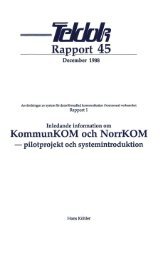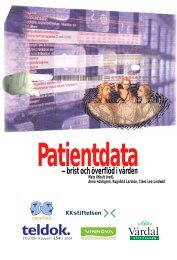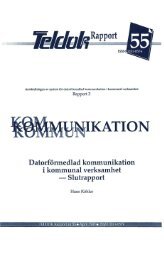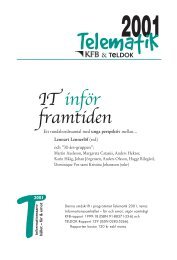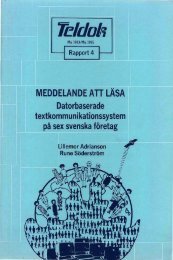Teldok rapport 41 - Digitalisering i förbundsrepubliken
Teldok rapport 41 - Digitalisering i förbundsrepubliken
Teldok rapport 41 - Digitalisering i förbundsrepubliken
You also want an ePaper? Increase the reach of your titles
YUMPU automatically turns print PDFs into web optimized ePapers that Google loves.
56 DIGITALISERING I FÖRBUNDSREPUBLIKEN<br />
voice services with the related consequences and expectations for all network<br />
components concerned.<br />
• This could result in the production of a larger number of items particularly in the<br />
field of terminals at relatively low manufacturing costs. Furthermore, it will be<br />
possible to reduce the unnecessary variety of terminals by streamlining the<br />
number of different types.<br />
• The ISDN involves a number of system-related and technological (i e component-related)<br />
challenges for the manufacturers which are certainly not free of<br />
risks but on the other hand will also be able to fulfil high expectations.<br />
ADVANTAGES FOR THE PTTs<br />
• The digitalisation of the telephone network is in itself independent of any ISDN<br />
implications - an economically useful measure, the advantages of which are outlined<br />
below:<br />
considerable savings in space owing to microelectronics;<br />
price reductions or equality of prices with a sometimes considerable increase<br />
in effidency;<br />
the prices of digital systems will continuw to fall while the prices for analogue<br />
systems will remain almost the same:<br />
noticeably lower operating costs;<br />
higher quality of service, higher efficiency.<br />
• Additionally, the concentional analogue or electromechanical technology will no<br />
longer be able to meet inte increased requirements in future.<br />
• The simultaneous use of several telecommunication networks for different<br />
applications usually involves extra cost for the development, technology,<br />
planning and operation of the different networks and their components, which<br />
are considerable in some cases particularly as far as switching systems and the<br />
subscriber line including signalling are concemed.<br />
• Avoidance of separate networks for different services.<br />
• It is a logical consequence of the basic dedsion to digitalise the telephone network<br />
for economic reasons to digitalise the existing subscriber lines of the digital<br />
telephone network as well, thus making the decisive step towards the ISDN. As<br />
the copper pairs of the subscriber lines represent by far the largest portion of the<br />
investments made in the telecommunication network up to now, it seems logical<br />
to modernise, i e digitalise them and thus make multiple use of them.<br />
• Economical use of the equipment of the digitahsed telephone network, especially<br />
the copper pair of the subscriber line.<br />
• The ISDN will offer new and improved services and service attributes within a<br />
relatively short time and at low extra costs.<br />
• Handling of several services over a single access with a single directory number.<br />
• The expansion of the ISDN in line with demand is supported by the modular<br />
design of the digital local exchanges (according to the building block concept).<br />
• The ISDN can also be expanded by integrating broadband services.<br />
To sum up. the ISDN may practically be regarded as a by-product of the digitalisation<br />
of the telephone network requiring only little extra expense since the most<br />
important and costly components of the ISDN are already available in the digitalised<br />
telephone network. The standard bit rate of 6 ' .:bii/s in the ISDN furthermore<br />
allows to implement all the essential telecommunication services in a single and<br />
highly efficient digital communication network.






